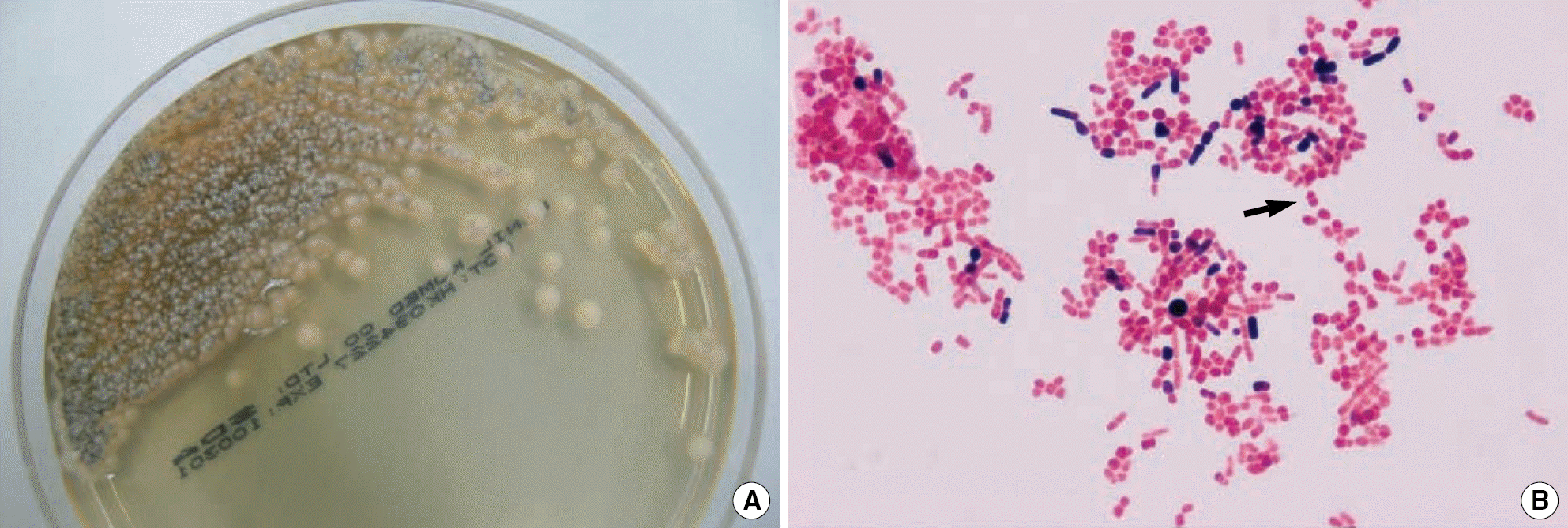Abstract
Penicillium marneffei is the only dimorphic fungus among Penicillium spp. that can cause a fatal infection in immunocompromised patients. P. marneffei is endemic in Southeast Asia and eastern China. P. marneffei infection is an AIDS-defining illness and the third most common opportunistic infection in the endemic regions. Here, the authors report a case of disseminated P. marneffei infection in a patient who underwent liver transplantation in China. During the hospital stay, the mold form of the fungus that produced a red wine-colored pigment on the agar plate was isolated from the patient's urine, transtracheal aspirate, and blood. The fungus was identified as P. marneffei by direct sequencing of the D1-D2 and ITS regions. Thermal dimorphism was also confirmed by subculturing the colony at 37°C. To the best of our knowledge, this is the first Korean case of disseminated P. marneffei infection in a liver transplant recipient.
REFERENCES
1.DiSalvo AF., Fickling AM., Ajello L. Infection caused by Penicillium marneffei: description of first natural infection in man. Am J Clin Pathol. 1973. 60:259–63.
2.Vanittanakom N., Cooper CR Jr., Fisher MC., Sirisanthana T. Penicillium marneffei infection and recent advances in the epidemiology and molecular biology aspects. Clin Microbiol Rev. 2006. 19:95–110.
3.Lee N. Penicilliosis: an AIDS-defining disease in Asia. Hong Kong Med J. 2008. 14:88–9.
4.Supparatpinyo K., Khamwan C., Baosoung V., Nelson KE., Sirisanthana T. Disseminated Penicillium marneffei infection in Southeast Asia. Lancet. 1994. 344:110–3.
5.Antinori S., Gianelli E., Bonaccorso C., Ridolfo AL., Croce F., Sollima S, et al. Disseminated Penicillium marneffei infection in an HIV-positive Italian patient and a review of cases reported outside endemic regions. J Travel Med. 2006. 13:181–8.
6.Larone DH. Medically important fungi: a guide to identification. 4th ed.Washington, DC: ASM Press;2002.
7.Wu TC., Chan JW., Ng CK., Tsang DN., Lee MP., Li PC. Clinical presentations and outcomes of Penicillium marneffei infections: a series from 1994 to 2004. Hong Kong Med J. 2008. 14:103–9.
8.Chan YH., Wong KM., Lee KC., Kwok PC., Chak WL., Choi KS, et al. Pneumonia and mesenteric lymphadenopathy caused by disseminated Penicillium marneffei infection in a cadaveric renal transplant recipient. Transpl Infect Dis. 2004. 6:28–32.
9.Lin JN., Lin HH., Lai CH., Wang JL., Yu TJ. Renal transplant recipient infected with Penicillium marneffei. Lancet Infect Dis. 2010. 10:138.
10.Wang JL., Hung CC., Chang SC., Chueh SC., La MK. Disseminated Penicillium marneffei infection in a renal-transplant recipient successfully treated with liposomal amphotericin B. Transplantation. 2003. 76:1136–7.
11.Woo PC., Lau SK., Lau CC., Chong KT., Hui WT., Wong SS, et al. Penicillium marneffei fungaemia in an allogeneic bone marrow transplant recipient. Bone Marrow Transplant. 2005. 35:831–3.
12.Han SH., Choi HY., Lee SC., Goo YS., Chang KH., Kang SW, et al. A case of Penicillium marneffei CAPD peritonitis. Korean J Nephrol. 2002. 21:680–5. (한상훈, 최훈영, 이상철, 구영석, 장경희, 강신욱 등.CAPD 환자에서 도관 균락화와 합병된 Penicillium marneffei 복막염1예. 대한신장학회지 2002;21:680-5.).
13.Dockrell DH., Mendez JC., Jones M., Harmsen WS., Ilstrup DM., Smith TF, et al. Human herpesvirus 6 seronegativity before transplantation predicts the occurrence of fungal infection in liver transplant recipients. Transplantation. 1999. 67:399–403.

14.Peto TE., Bull R., Millard PR., Mackenzie DW., Campbell CK., Haines ME, et al. Systemic mycosis due to Penicillium marneffei in a patient with antibody to human immunodeficiency virus. J Infect. 1988. 16:285–90.
15.Jones PD., See J. Penicillium marneffei infection in patients infected with human immunodeficiency virus: late presentation in an area of nonendemicity. Clin Infect Dis. 1992. 15:744.
16.Vanittanakom N., Sirisanthana T. Penicillium marneffei infection in patients infected with human immunodeficiency virus. Curr Top Med Mycol. 1997. 8:35–42.
17.Lim D., Lee YS., Chang AR. Rapid diagnosis of Penicillium marneffei infection by fine needle aspiration cytology. J Clin Pathol. 2006. 59:443–4.
18.Cao C., Li R., Wan Z., Liu W., Wang X., Qiao J, et al. The effects of temperature, pH, and salinity on the growth and dimorphism of Penicillium marneffei. Med Mycol. 2007. 45:401–7.
19.Cao L., Chan KM., Chen D., Vanittanakom N., Lee C., Chan CM, et al. Detection of cell wall mannoprotein Mp1p in culture supernatants of Penicillium marneffei and in sera of penicilliosis patients. J Clin Microbiol. 1999. 37:981–6.
20.Huang YT., Hung CC., Liao CH., Sun HY., Chang SC., Chen YC. Detection of circulating galactomannan in serum samples for diagnosis of Penicillium marneffei infection and cryptococcosis among patients infected with human immunodeficiency virus. J Clin Microbiol. 2007. 45:2858–62.
21.Pongpom M., Sirisanthana T., Vanittanakom N. Application of nested PCR to detect Penicillium marneffei in serum samples. Med Mycol. 2009. 47:549–53.
22.Pornprasert S., Praparattanapan J., Khamwan C., Pawichai S., Pimsarn P., Samleerat T, et al. Development of TaqMan real-time polymerase chain reaction for the detection and identification of Penicillium marneffei. Mycoses. 2009. 52:487–92.
23.Hsiue HC., Huang YT., Kuo YL., Liao CH., Chang TC., Hsueh PR. Rapid identification of fungal pathogens in positive blood cultures using oligonucleotide array hybridization. Clin Microbiol Infect. 2010. 16:493–500.

24.Supparatpinyo K., Perriens J., Nelson KE., Sirisanthana T. A controlled trial of itraconazole to prevent relapse of Penicillium marneffei infection in patients infected with the human immunodeficiency virus. N Engl J Med. 1998. 339:1739–43.
25.Sirisanthana T., Supparatpinyo K., Perriens J., Nelson KE. Amphotericin B and itraconazole for treatment of disseminated Penicillium marneffei infection in human immunodeficiency virus-infected patients. Clin Infect Dis. 1998. 26:1107–10.
Fig. 1.
Penicillium marneffei cultured at room temperature. (A) A colony producing a red wine-colored pigment that diffused into the Sabouraud dextrose agar plate. (B) Septated hyphae with phialides branching from the conidiophores and chain-shaped microconidia (Lactophenol cotton blue stain, ×400).





 PDF
PDF ePub
ePub Citation
Citation Print
Print



 XML Download
XML Download